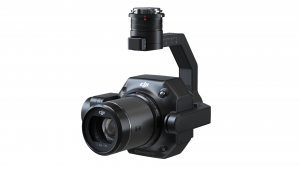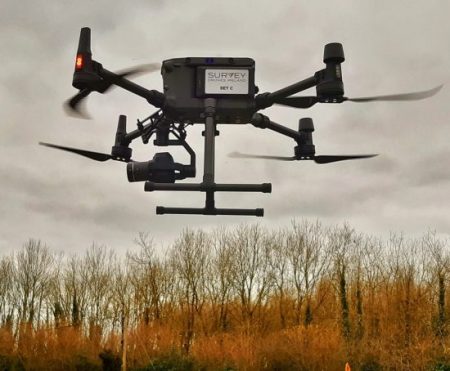
DJI Zenmuse P1
The Zenmuse P1 represents the first time DJI has introduced a full-frame sensor camera onto one of their drones. With competition having already made full-frame data acquisition possible, the release of the Zenmuse P1 is a very welcome addition to DJI’s lineup and is exclusively compatible with the Matrice 300.
Zenmuse P1 Complete with 35mm Lens
DJI’s First Full-Frame Advantages
The Zenmuse P1 sensor is a staggering 7.5x larger than the very capable Phantom 4 RTK camera at a size of 35.9 mm x 24 mm with 45 effective pixels (45MP).
What does the Zenmuse P1 mean for photogrammetry?
Cleaner Results
The biggest advantage of any full-frame camera is its ability to capture a large amount of light compared to smaller cropped sensors. Since photogrammetry uses passive sensing to capture data, it is entirely reliant on light in the environment to achieve results.
At lower levels of light photogrammetry can often be affected quite badly due to camera compensations through introducing digital noise such as ISO, reducing pin-sharp quality by opening the aperture too much and risking image blur with slow shutter speeds.
Full-frame sensors maximise the use of environmental light by having more physical sensor space to capture images.
One slight limitation of the Zenmuse P1 is that it does not have the full range of flexibility and settings that would normally be available on full-frame DSLR cameras. It has the simplified Phantom 4 setting selections of ISO, aperture and shutter speed but not a whole lot more for a full-frame camera.
Moreover, the ISO jumps from 400 to 800 meaning there is a significant jump in image noise. At low levels of light users may require an ISO of 640 as to not overcompensate with open apertures and slow shutter speeds introducing potential blur. It must be noted however, these are only slight critiques of an otherwise extremely capable and impressive camera.
Larger Area Covered
The larger sensor means that a larger ground area can be covered by the M300. The image below shows a comparison with the Phantom 4 RTK. The Zenmuse P1 produces an image length and width which is 1.5x larger than the Phantom. This results in shorter missions while still maintaining great results.
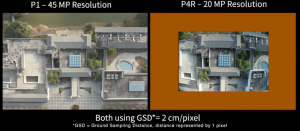
Global Shutter
Image blur is a make-or-break issue in photogrammetry. There is no real way to recover a dataset filled with blurry images. This is why it is critical to mitigate blur entirely if possible. Two features of the Zenmuse P1 that help with this are its global shutter and shutter priority setting.
Global shutters, in contrast to rolling shutters, expose the sensor to light instantaneously rather than moving across the sensor. This can greatly reduce image blur and mitigate the ‘jello effect’ in which ground features appear very distorted, compressed or enlarged. The jello effect introduces plenty of ambiguity for photogrammetric processing which effectively means less accuracy and more noise.
Lens Selection
The Zenmuse P1 has three prime lenses to choose from. Each lens has a fixed focal length of 24 mm, 35 mm and 50 mm respectively. Since each lens is fixed and not zoom it allows them to be very lightweight with a slim carbon fiber external housing perfect for mounting to the M300.
The most commonly used 35 mm lens reduces distortion compared to wider view lenses meaning photogrammetric processing is more accurate and reliable. Good quality lenses also mean more matching tie points during photogrammetry processing.

Timesync
Timesync allows the P1 and M300 to synchronize across the flight controller, camera and RTK data. What this means is that the accuracy of each geotagged image is maximised achieving centimetre level positioning data without the use of GCP’s. DJI states that the P1 and M300 can achieve an accuracy of 30 mm and 50 mm in horizontal and vertical respectively using Timesync.
Smart Oblique
The smart oblique feature is a fantastic addition for aerial surveying. It allows images to be captured in multiple directions along with the mission from full oblique to nadir enabling the M300 to cover up to 7.5 km squared per day. However, it must be noted that the area covered is height and speed-dependent.
Not only does the Smart Oblique function enable faster data capture but also increases the efficiency of each mission by only capturing data that is necessary for 3D reconstruction. This reduces the overall number of images greatly compared to the Phantom 4 RTK. DJI tests show a 53% reduction in images which equates to a drop of 427 images to just 97. A very impressive reduction particularly considering images file sizes are larger and processing a huge number of P1 images may strain a computer’s processing capability.
Testing also showed a significant decrease in flight time which resulted in the M300 and P1 being 4.7x faster compared to the Phantom 4 RTK.
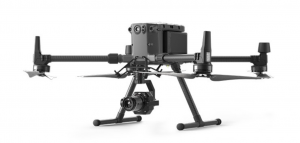
DJI’s Photogrammetry Solution
The Zenmuse P1 is a fantastic addition to DJI’s product line. A full-frame sensor in combination with a selection of lenses and a range of functionality such as Smart Oblique and Timesync, the P1 is a marked improvement for photogrammetric specific missions.
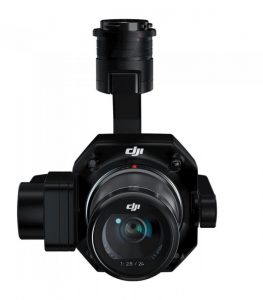
Get in touch with one of our experts at Survey Drones Ireland to see if the Zenmuse P1 solution is the right fit for your drone operations.
If you need further advice on this product please send an email to info@surveydrones.ie or fill in the contact page on this website or Click Here to know more.

